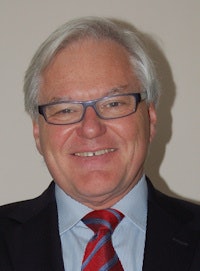
The regulatory war of words over the status and definition of teleradiology took an important new turn at last week's EU summit on e-healthcare, when national decision-makers and authorities from 27 member states gathered in Dublin.
"The e-health stakeholder group established teleradiology as a medical act and this is a big achievement. The commission now needs to urge governments to specify this distinction in legislation," said Dr. Jan Schillebeeckx, the Belgian radiologist who represented the European Society of Radiology (ESR) at the meeting. He added that Poland was among countries that did not consider teleradiology a medical act because the doctor and patient are not in the same room.
 Distinguishing teleradiology from telemonitoring in political circles is a game changer for radiologists, according to Dr. Jan Schillebeeckx.
Distinguishing teleradiology from telemonitoring in political circles is a game changer for radiologists, according to Dr. Jan Schillebeeckx.
Updates to directives applicable to telemedicine will clarify professional qualification and licensing issues for radiologists and other telespecialists as member states advance their digital healthcare agendas, delegates heard in Dublin. The summit was a key component of e-Health Week, an event hosted by the Republic of Ireland, which currently has the presidency of the Council of the European Union. Stakeholders discussed the eHealth Action Plan 2010-2020, the motor behind the commission's plan for widespread deployment of telemedicine over the next seven years.
"Healthcare is in the remit of member states. For a long time, EC [European Commission] officers and politicians have seen teleradiology in the same light as telemonitoring, and most national laws have reflected this, despite the fact that teleradiology is a medical act," Schillebeeckx said.
Without such a definition, anyone could practice teleradiology without appropriate qualifications, he pointed out, adding that as member states geared up for action plan 2020 implementation, it was vital for them all to be in line on this issue. This view shared by the ESR and other groups will be underlined in an advising document for DG Connect, the department responsible for managing the commission's digital agenda.
Schillebeeckx described how updates in areas such as licensing and privacy will clarify hitherto gray areas in the directives and regulations that are flagged in the existing European Commission Staff Working Document on the applicability of the existing EU legal framework to telemedicine services: SWD(2012) 413 final.
"From a legal perspective, it has always been clear that the telespecialist needs to be licensed in the country where practice is delivered and not in the country where the patient is based. However this will be underlined in a directive update this summer," Schillebeeckx said.
Background on the topic is provided in this press release. Also new is a privacy regulation, to be officially passed this year, relating to patient health data and applying to healthcare as a whole, not just telemedicine. It will allow patients to opt out of data distribution or sharing. Click here for details.
The stakeholder group acknowledged inequalities in IT literacy and Internet access among patients and professionals across Europe, despite patients' fundamental right to access centrally stored data such as records, medical images, and reports. Such inequalities present an ongoing challenge to wide deployment of telemedicine, according to Schillebeeckx. Furthermore, teleradiology patients need to be made aware that their images will be read and reported elsewhere, be this in another country or another hospital.
"There needs to be a mechanism to allow patients to check the identity and qualifications of the radiologist who will read and report on the image, though how this will be done is not yet clear," he commented.
He said such a tool might be created through member states establishing a repertory, with the obligation to do so covered in Directive 2011/24/EU on the application of patients' rights in cross-border healthcare, which gives patients the right to seek healthcare in other countries, or in Directive 2000/31/EC (the "e-Commerce Directive"), given teleradiology's role as an information service.
Ahead of the G8 talks taking place in Lough Erne, Enniskillen, in June, the Dublin summit last week also found itself an arena for exchange on the EU-U.S. trade agreement and how it will affect healthcare. Delegates at the summit's open meetings, which were attended by politicians and health ministers from member states and European commissioners, were told how the Memorandum of Understanding signed by the EU and U.S. in 2010 and confirmed in 2011 paves the way to setting up a road map for e-health interoperability, allowing professionals on both sides of the Atlantic to work together, according to Schillebeeckx.



















